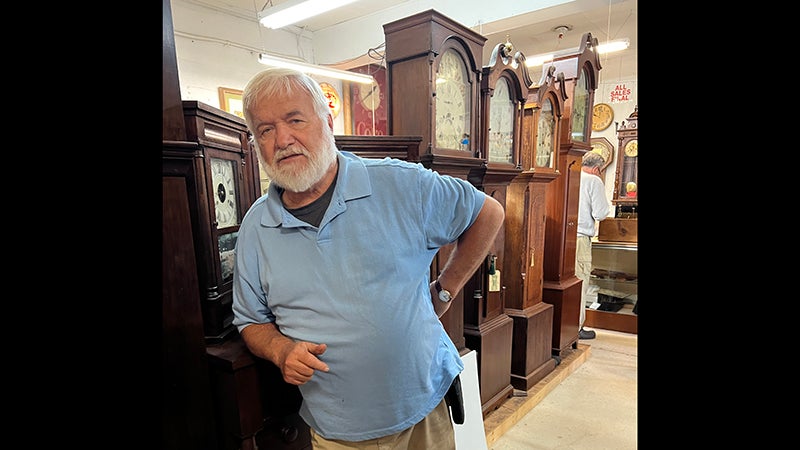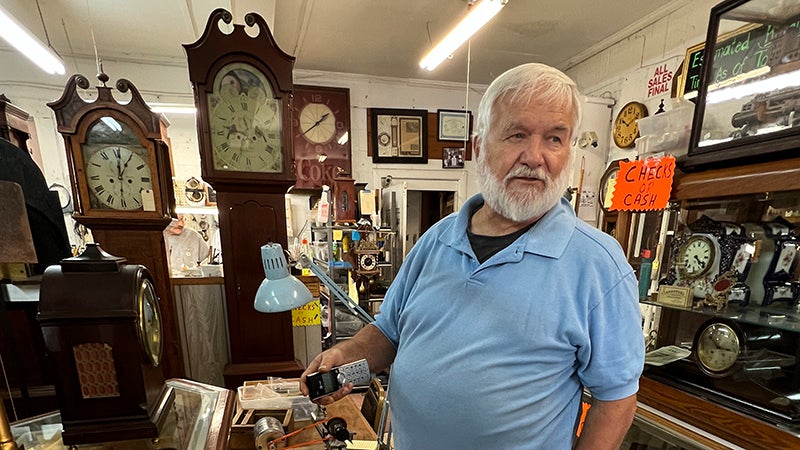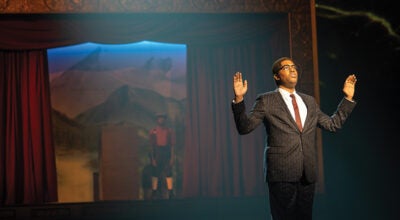Time in his Hands
Published 7:41 pm Friday, April 21, 2023
Story by Phyllis Speidell
Photos by John H. Sheally II
A walk around Robinson’s Antique Clocks in Carrollton is a stroll through time.
If you are lucky enough to catch Rick Robinson when he is not deep into the complex works of an old timepiece or teaching a class how to work on clocks, he is a master guide through the history ticking there.
From stately grandfather clocks to a small Mickey Mouse wall clock, the shop holds hundreds of timepieces — some hand-painted, some with wooden works, even one built into an 1880s handcrafted model of a locomotive. Each one, whether it is there for repair or is part of Robinson’s personal collection, has a story.
Robinson has his own story as well. Originally from Franklin, New York, a small town about 12 miles from Oneonta, he discovered his mechanical aptitude early. He rebuilt a small engine when he was 10 years old and then went on to restore an 1880 Ansonia iron case mantel clock pulled from his grandmother’s attic.
“I realized that I could fix things that stumped the adults,” he said.
About 40 years ago, Robinson, now 69, moved to Yorktown to rebuild wrecked cars for his uncle. He moved to Denbigh and then settled in the Morgarts Beach area. In the mid-1980s he started teaching auto body repair and refinishing at the former Pruden Vo-Tech Center, now the College and Career Academy at Pruden, in Suffolk. Teaching, for him, was fulfilling but exhausting.
He also repaired clocks in his home as a sideline but needed more room to work and to store his clock collection as well as the growing inventory he was repairing. In 2000, he left teaching and opened his shop on Brewers Neck Road.
“Two of the best things I’ve done were getting into teaching and then walking away 12 years later,” he said, and then quipped, “I enjoy clocks. Clocks don’t talk back – at least not out loud.”
“For a while, people didn’t know I was here,” he said, remembering that cars sped along Brewers Neck without glancing his way.
“But by about 2009 business really picked up,” he said, adding that now he has a waiting list to take new orders.
Robinson knows that qualified clock repair people are scarce. The trade is shrinking with very few young people interested in a career in horology – the science of measuring time and how to build and work on timepieces. With that in mind, Robinson shares his expertise with a few students, often more senior adults. Some become friends who visit regularly and may help at the shop.
As Robinson walked through his shop, he talked about some of the older and more unique timepieces. In the early 1800s, he said, clocks ran on wooden movements. Clock movements were first mass produced about 1806 and the first metal movements, made of brass, introduced about 1835. He also explained that antique clocks, like most antiques today, are not as sought after.
For 30 years, Robinson has been an active member of the Old Dominion Chapter 34 of the National Association of Watch & Clock Collectors, currently as president. He also evaluates clocks and watches at Antique RoadShow-type events and is a licensed auctioneer. He consistently sees prices dropping, such as American tall case clocks, 80 to 95 years old, valued at $20,000, going for only $500 to $1,000, much to the disappointment of the seller.
Through his work Robinson constantly meets people, a few well known, including the late country star Roy Clark. Robinson repaired a clock for Clark’s parents in Keysville and met the singer, who had come home for a little deer hunting. And others, less known but just as interesting, including the Swiss Commercial attaché who hired him to repair the American Ansonia schoolhouse clock he had picked up in South Africa and then invited Robinson to his wedding.
In 2016, Robinson accepted a request to repair a 1910 clock topping the historic 18th century Steeple Building in Christiansted, St Croix, Virgin Islands. The United States purchased St. Croix, St. Thomas and St. John for $25 million in 1917 and the Virgin Islands became U.S. territories. Five years later, the U.S. Navy gave the clock to the residents of Christiansted to commemorate the purchase, but after a century, no one is sure why the Navy chose a clock as a gift. The people of Christiansted did know, however, that they missed hearing their clock chime. It had fallen silent in 2010.
Under Robinson’s touch, the clock chimed again, counting the hours, on the hour, every hour, by the Transfer Day Centennial Celebration in March 2017.
“I enjoy bringing something that old back to life again and I enjoy meeting the people,” he said. “I enjoy meeting the collectors and sharing what I know with people who want to learn.”
Asked for the best advice he could give owners of antique timepieces, Robinson emphasized maintenance. Antique clock works require oiling every three years. If the owner doesn’t know how to do that, he said, they should call a trusted professional who cares about their work rather than rely on a YouTube video for do-it-yourself directions.











